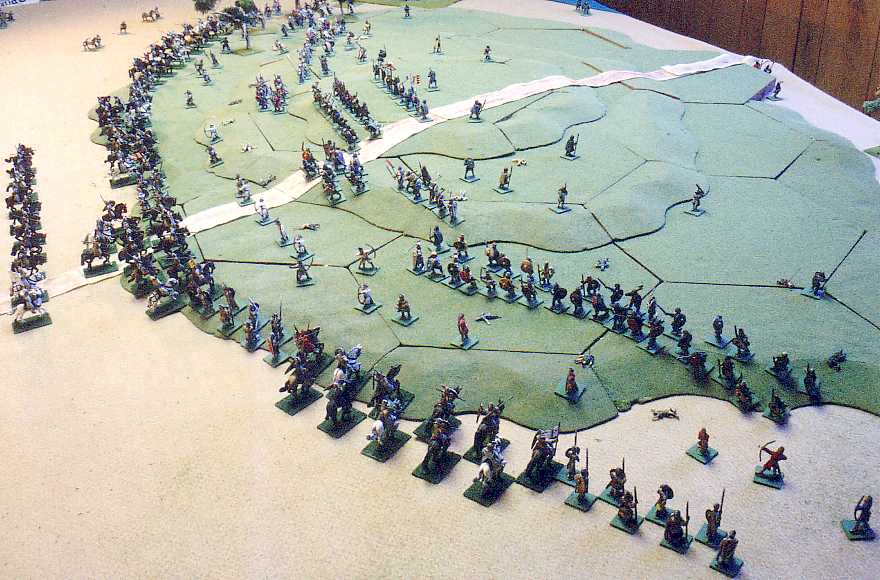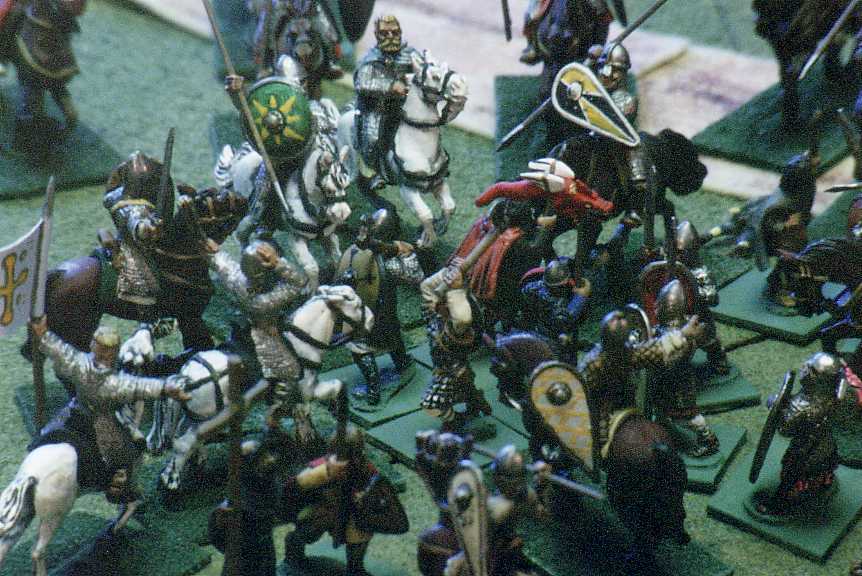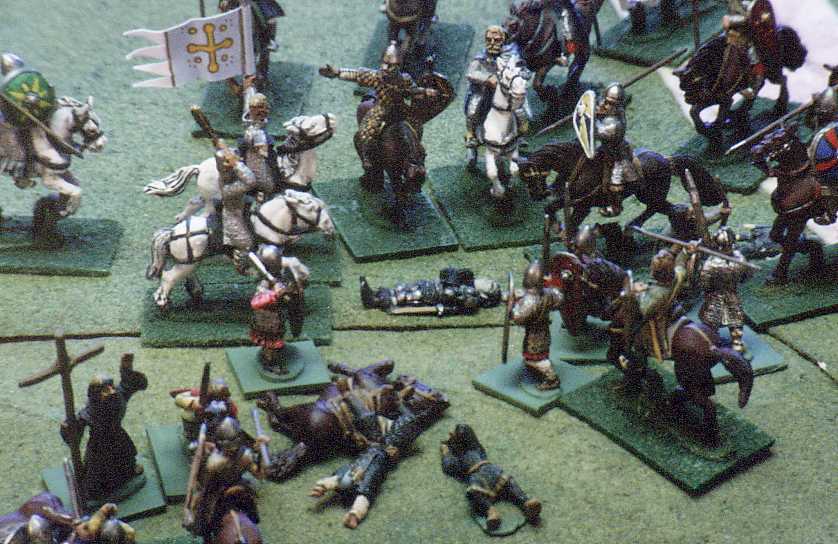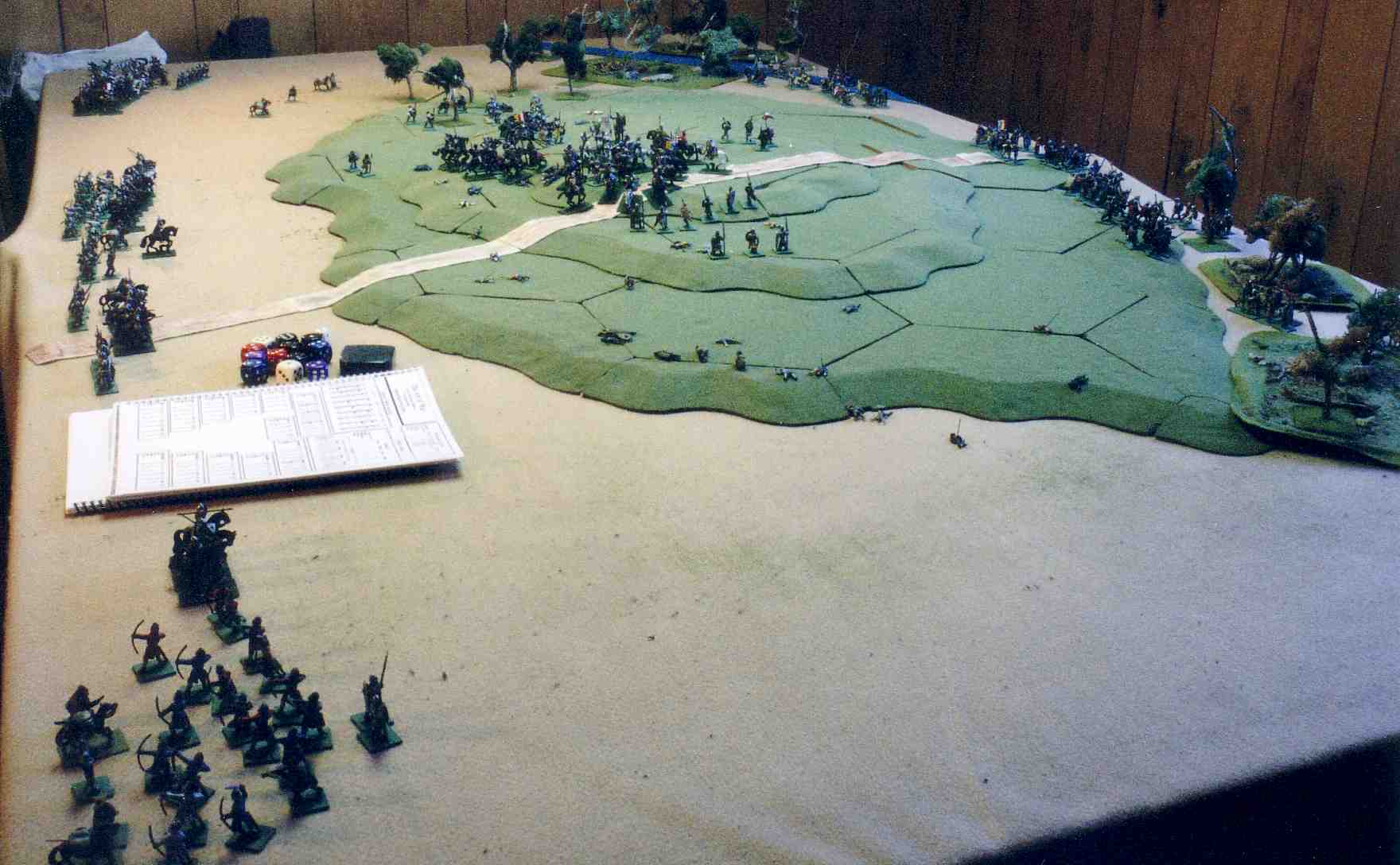Turn by turn development of the battle of Hastings
using the wargame rules The Art of War

Rout of the marksmen, and the English pursuit
The English, having moved to throw hand missiles, were no longer in shieldwall. At close range the bows and crossbows took a heavy toll. But the casualties from the massed, close order javelin fire was much worse. In front of the English phalanx there were only a handful of figures left: so the Franco-Norman marksmen units had to check morale for losses first: they all failed down the line. The English left and right had also suffered at least 25% casualties in the missile exchange, but since their enemies were already vanquished and running away, the English wings did not have to test morale at this time. However the sight of their enemies fleeing before their faces required a performance check from the entire English army to not pursue. The command of Leofwin saw his thegns and housecarles stand firm, but his geneats and ceorls broke ranks and chased after the fleeing marksmen. In the center, Harolds housecarles stood firm, but the geneats and thegns were out of control and began to run down their enemies. Also on the left: Gyrth's command took off in a body after the routed Franco-Norman marksmen, leaving Gyrth with only his housecarles holding their ground. This is the point shown in the picture above.
Shortly after the position in the picture, the rest of duke William's army moved up the hill, the archers and crossbowmen slipping through their open order ranks as they made their escape: they played no further part in the battle. Closing ranks, the heavy infantry and cavalry met the advancing main English army and engaged them. In some places the English managed to get off another round of javelins: and the housecarles got off a further round at the point of melee contact, as did some thegns: but the geneats' and ceorls' level of training wasn't good enough to allow them to throw as many rounds. Nevertheless, the casualties, especially amongst the Bretons, were severe. The Breton left routed away, following their erstwhile missile screen. In fact, the entire Breton wing was annihilated or routed off.
Seeing the Breton left defeated, William's reserve wavered and began to withdraw in rout toward Telham hill. It took William two turns to get them back (right on the edge of the table; had they failed a third time in trying to recover morale, that would have been the battle right there: William riding off the field, a first, and it almost happened). Elements in the English army were now discomfitted by superior arms and numbers: especially the English left fared badly in their extended and loosened condition, because of the effects of the missile exchanges. The French right held up to their own 25% casualty checks; and the English left also made their morale test for casualties at this time: but it only prolonged the inevitable a little longer: Gyrth saw his men below cut down, then the French cavalry were upon him and his diminished unit of housecarles. Gyrth himself fought badly: with odds of two to one in a melee exchange, Gyrth managed to "kill himself" (rolled snake eyes), taking his figure and another housecarle with him. (One Godwinson down, two to go.)
The Norman infantry had toiled up the hill and engaged the scattered elements of the English right, especially Leofwin's housecarles. Leofwin battled for several turns against two to one odds, but was cut down. Nearly all the lefthand Norman cavalry unit had been destroyed, fighting Harold's center. But a large part of Harold's housecarles who had taken the brunt of the Norman cavalry attack routed when they checked for casualties: he moved his reserve into line and the dregs of the forward-most housecarles rallied upon his unit.

The final attacks
The picture shows the battle at this point. William's reserve came up finally and entered the battle. Without them the Normans would have lost, or only stood upon a drawn field. The French and other Norman cavalry, still a powerful force, came up in line with the Norman reserve and swung into position to attack Harold's last stand. Meanwhile, the English right advanced across the hill toward their king and his desperate situation, mopping up the last elements of the Breton division: but they were too late and too few to effect a change in the outcome.

Harold's last stand
In the background you can see a couple of rallied Breton cavalry being done to death by elements of the English right. And a handful of Breton infantry are also coming toward the main fight. But also you can see the Norman infantry (which had come 180 degrees right around) routing at last from taking losses: the English right pursued them and the Breton dregs routed again, seeing this setback.
Meanwhile, all the Franco-Norman cavalry close in upon Harold's exposed position.

The English line is broken
In the center of the picture, the Fighting Man can still be seen beside the Dragon of Wessex: Harold's raised axe is visible between them. The final encounter has come.

Detail of Harold's death
In this hopeless situation, Harold, his remaining standard bearer (holding aloft the Dragon), a housecarle and a geneat fight back to back. But there were to be no heroics: In a single turn of melee combat, all four were cut down by the two to one odds. William's figure is frontally in contact with Harold's, a la the Carmen account.

Respect for the royal remains
"Our" Harold looks considerably better laid out than the historical Harold, who was apparently cut to pieces by William's knights.

The dead on the sidelines, the survivors in the middle
This picture shows just how evenly fought number nineteen was: right up to the end, there was a chance that a rout could ruin William's victory: his lone righthand cavalry unit banner bearer almost got killed (units which get wiped out cause morale tests upon all friendly units which see it happen, so that was a close one); and when the Norman heavy infantry unit which had killed Leofwin routed, William's reserve had to test for seeing this happen. That was way too many morale checks to be comfortable with, if you were rooting for the Normans: Harold's luck was generally worse throughout the battle. But the great slaughter amongst the Franco-Normans shows that the English did not go down to defeat easily.
An interesting feature of this refight was the fact that the English right never did have to roll for a casualty morale check: each time they fought another enemy unit, they inflicted 25%+ casualties upon it, and it broke in rout first: thus negating any requirement for the English right to test for their own considerable losses. The fate of the English right was to pursue the last of the Bretons and the Norman lefthand infantry unit off the field, and then to flee for their own lives as the cavalry came swiftly from the execution of Harold to destroy them. I did not play out the final scattered fracases, as the battle was clearly a Norman victory (with all three Godwinson brothers dead).






